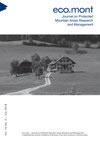Linking visitors’ spatial preferences to sustainable visitor management in a Norwegian national park
IF 0.8
4区 环境科学与生态学
Q4 BIODIVERSITY CONSERVATION
Eco Mont-Journal on Protected Mountain Areas Research
Pub Date : 2020-01-01
DOI:10.1553/eco.mont-12-1s27
引用次数: 5
Abstract
The increasing numbers of tourists visiting national parks contribute to new oppor tunities as well as challenges. Alpine and Arctic national parks in Northern Europe are key habitats for vulnerable species such as wild reindeer (Rangifer tarandus tarandus), and there is a significant need for management tools that can reduce the negative impacts of tourism. To gain knowledge about visitors' motivations and spatial preferences, we carried out a survey of people (n = 498) on paths in part of Rondane National Park, Norway. The results indicate that a large share of the visitors in the central, vulnerable part of the National Park may find their desired recreation al benefits in the less vulnerable fringe entrance areas. We discuss theoretical and practical implications of the results and how to increase knowledge about visitors' spatial preferences in order better to regulate their behaviour with the aim of reduc ing impacts on vulnerable fauna. Profile挪威国家公园将游客的空间偏好与可持续游客管理联系起来
越来越多的游客来到国家公园,既带来了新的机遇,也带来了新的挑战。北欧的高山和北极国家公园是野生驯鹿(Rangifer tarandus tarandus)等脆弱物种的主要栖息地,迫切需要能够减少旅游业负面影响的管理工具。为了了解游客的动机和空间偏好,我们在挪威朗丹国家公园的部分路径上对人们(n = 498)进行了调查。结果表明,在国家公园的中心脆弱部分,大部分游客可能会在不那么脆弱的边缘入口区域找到他们想要的娱乐利益。我们讨论了研究结果的理论和实践意义,以及如何增加对游客空间偏好的认识,以便更好地调节他们的行为,以减少对脆弱动物的影响。配置文件
本文章由计算机程序翻译,如有差异,请以英文原文为准。
求助全文
约1分钟内获得全文
求助全文
来源期刊

Eco Mont-Journal on Protected Mountain Areas Research
BIODIVERSITY CONSERVATION-ECOLOGY
CiteScore
1.20
自引率
0.00%
发文量
1
审稿时长
>12 weeks
期刊介绍:
eco.mont offers a platform specifically for scientists and practitioners working in and on protected mountain areas in Europe and overseas.Target audiences of the journal are scientists from all related disciplines, managers of protected areas and an interested public including practitioners, visitors, teachers, etc.
 求助内容:
求助内容: 应助结果提醒方式:
应助结果提醒方式:


